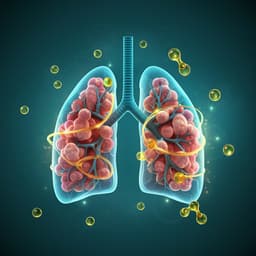
Food Science and Technology
Ginger essential oil prevents NASH progression by blocking the NLRP3 inflammasome and remodeling the gut microbiota-LPS-TLR4 pathway in mice
S. Panyod, W. Wu, et al.
Discover how ginger essential oil (GEO) could be a game-changer in preventing non-alcoholic steatohepatitis (NASH) as revealed by a remarkable study conducted by Suraphan Panyod and colleagues. GEO has shown potential to reduce inflammation, improve antioxidant levels, and enhance gut microbiota balance in a murine model, suggesting significant implications for dietary supplementation against NASH.
~3 min • Beginner • English
Introduction
The study addresses whether ginger essential oil (GEO) can prevent or attenuate progression of non-alcoholic steatohepatitis (NASH) induced by a palm oil-containing high-fat diet (P-HFD) and lipopolysaccharide (LPS) in mice. NASH, a severe form of NAFLD, involves steatosis, inflammation, and hepatocyte ballooning and can progress to cirrhosis and hepatocellular carcinoma. Under a multiple-hit hypothesis, dietary factors, lifestyle, and gut microbiota interact with genetic/epigenetic factors to drive hepatic lipid accumulation, oxidative stress, and inflammation. HFD elevates FFAs and lipogenesis (SREBP-1c) and cholesterol synthesis (HMGCR), decreases β-oxidation (PPARα), increases CYP2E1-derived ROS, and activates NLRP3 inflammasome, producing IL-1β/IL-18. Diet-induced dysbiosis and intestinal permeability enable gut-derived PAMPs (e.g., LPS) to activate hepatic TLR4/NF-κB signaling, promoting inflammatory cytokines (TNF-α, IL-6, IL-1β) and NASH progression. The authors developed a palm oil GAN diet model with LPS injections (PL) that better recapitulates human dietary exposures and induces dysbiosis and endotoxemia. Prior work shows GEO has hepatoprotective, antibacterial, antifungal, and microbiota-modulating effects. The hypothesis is that GEO prevents NASH via antioxidant activity, suppression of NLRP3 inflammasome, and remodeling of the gut microbiota-LPS-TLR4 axis.
Literature Review
- Diet–microbiota interactions are pivotal in NASH pathogenesis; unhealthy diets induce dysbiosis, barrier leakage, and hepatic inflammation via TLRs (especially TLR4) and NF-κB, elevating TNF-α, IL-6, and IL-1β. LPS can promote hepatocarcinogenesis and exacerbate NASH.
- Traditional trans-fat HFD models effectively induce NASH but poorly reflect current human diets due to regulatory bans; palm oil-containing GAN diets yield comparable NASH phenotypes and better clinical translatability. A PL model (P-HFD plus LPS) increases dysbiosis and endotoxemia relative to diet alone.
- GEO from Zingiber officinale shows hepatoprotection in HFD-induced NAFLD, antibacterial/antifungal activity, and ameliorates atherosclerosis by modulating TMAO and the microbiota. The role of GEO in NASH, its effects on gut–liver axis, and NLRP3 inflammasome had not been defined.
- Oxidative stress (CYP2E1-driven ROS) and impaired antioxidants (GSH, CAT, SOD) are implicated in NASH; NLRP3 inflammasome activation contributes to steatosis, inflammation, and fibrosis, and its inhibition is beneficial. LPS/TLR4/NF-κB primes NLRP3 activation. Citral (neral, geranial), the main GEO component, has anti-inflammatory activity and can suppress NLRP3 and pro-IL-1β in vitro.
Methodology
- GEO preparation and composition: Fresh aged ginger (Zingiber officinale Roscoe) from Nantou County, Taiwan, was steam-distilled (~6 h); yield ~0.14% w/w. Water removed by freezing at −20 °C. GC-FID analysis (Thermo Focus GC, Stabilwax column 60 m × 0.32 mm, 1 μm) showed citral (~31%) as main component: neral 18.8%, geranial 12.2%.
- Animals and experimental design: Male C57BL/6J mice, 6 weeks old, acclimated 2 weeks. Randomized into five groups (n=7–8/group): control diet (10% kcal fat); PL: palm oil GAN diet (40% kcal fat mainly palm oil, 20% fructose, 2% cholesterol) plus weekly i.p. LPS 500 μg/kg; PL+GEO low (12.5 mg/kg/day), medium (62.5 mg/kg/day), high (125 mg/kg/day). GEO administered by daily oral gavage for 12 weeks. Body weight and food intake weekly. At week 12, euthanasia by CO2 asphyxiation; blood collected; liver and adipose depots (visceral, subcutaneous, eWAT, IWAT, pWAT, mWAT, isWAT, IBAT), spleen, kidney, cecum harvested and weighed; colon fecal contents collected for sequencing. IACUC approval NTU-110-EL-00060.
- Histopathology: Right liver lobe fixed in 10% neutral formalin; FFPE; NAS scoring (steatosis, lobular inflammation, ballooning) by blinded pathologist; NAS 5–8 diagnostic for NASH.
- Plasma biochemistry: Plasma (1000 × g, 15 min, 4 °C) analyzed (Beckman Coulter AU 5800) for total cholesterol, triglycerides, LDL, HDL, AST, ALT, glucose.
- Hepatic antioxidant and inflammation assays: Liver homogenates (8 mM KH2PO4, 12 mM K2HPO4, 1.5% KCl, pH 7.4) assayed for GSH, GPx, GRd, SOD, CAT (Cayman Chemical). Hepatic TNF-α, IL-1β, IL-6 by ELISA (Invitrogen).
- Western blot: Protein extracted (urea/thiourea/CHAPS buffer with inhibitors), quantified (Bio-Rad). SDS-PAGE and PVDF transfer; blocked in 5% BSA/TBST. Primary antibodies: SREBP-1c, HMGCR, PPARα, CYP2E1, GAPDH (GeneTex); NLRP3, ASC (Abcam); caspase-1 (Santa Cruz); TLR4, NF-κB (Cell Signaling). HRP secondary antibodies, ECL detection (PerkinElmer), imaging (UVP BioSpectrum). Densitometry with ImageJ; normalized to GAPDH. Protein expression n=3.
- Microbiome profiling: Colon fecal DNA (QIAMP PowerFecal Pro). V3–V4 16S rRNA amplification (Illumina adapters added via Nextera XT), cleanup (AMPure XP), QC (Bioanalyzer). Paired-end MiSeq 2×300 bp. QIIME2 pipeline: quality filtering, denoising, merging, chimera removal (dada2), taxonomy via SILVA v132. Alpha diversity (observed ASVs, Shannon, Simpson) and Bray–Curtis PCoA; Adonis (vegan) for beta-diversity differences; heatmap (heatmap3). Spearman correlations between genera and NASH parameters.
- LPS quantification: Plasma and liver homogenate (10 μL) incubated with murine TLR4/NF-κB/SEAP HEK293 reporter cells for 24 h; LPS detected using HEK-Blue LPS Detection Kit; absorbance at 620 nm.
- Intestinal permeability: FITC-dextran (15 mg in 0.2 mL PBS) gavage 3 h before sacrifice; plasma fluorescence (Ex 485/Em 538 nm).
- Statistics: Mean ± SD. One-way ANOVA with Dunnett’s test vs PL unless specified; repeated-measures ANOVA for body weight; Wilcoxon/Kruskal–Wallis/Dunn’s for microbiome where applicable. GraphPad Prism 9.1.2; R 3.6.1/RStudio 1.2.5001.
Key Findings
- GEO composition: Citral (~31%; neral 18.8%, geranial 12.2%) was the main GEO component.
- Obesity/metabolic outcomes: PL increased body weight vs control (final BW 30.8 ± 2.0 g vs 26.9 ± 0.8 g; p=0.0028) and total fat mass (up to 195% of control; p<0.0001). GEO (medium/high) significantly attenuated body weight change (repeated-measures ANOVA p<0.0001) without altering energy intake.
- Plasma biomarkers: PL elevated glucose (p<0.0001), total cholesterol (p<0.0001), HDL-C (p=0.0004), LDL-C (p<0.0001); triglycerides decreased vs control. GEO (medium) reduced glucose (p=0.0577) and triglycerides (p=0.0125); GEO (medium and high) reduced LDL-C (p=0.0312; p=0.0001). Low-dose GEO trended to improve HDL-C (p=0.0666).
- Liver injury and NAS: ALT increased in PL vs control (p=0.0208); GEO reduced ALT in PL+GM and PL+GH (p=0.0104; p=0.0044). Liver weight increased with PL (p=0.0006), not reduced by GEO. GEO reduced NAS components, notably hepatocyte ballooning (reduced score in PL+GM and PL+GH; p=0.0499), indicating NASH prevention.
- Oxidative stress/antioxidants: PL increased CYP2E1; GEO tended to reduce CYP2E1. PL reduced SOD and GSH; GEO enhanced CAT, GSH, and GRd; GPx trended upward, with the high dose showing the greatest overall antioxidant benefit (ANOVA significant for several measures as shown in Fig. 3).
- Inflammation and NLRP3 inflammasome: PL elevated hepatic TNF-α, IL-1β, IL-6. GEO reduced IL-1β (medium p=0.0013; high p<0.0001) and IL-6 (medium p<0.0001; high p<0.0001); high-dose GEO reduced TNF-α (p=0.0012). PL increased hepatic NLRP3 and ASC expression (p=0.0012; p=0.0011); all GEO doses significantly suppressed NLRP3 and ASC (p<0.05). Caspase-1 trended to increase with PL and decrease with GEO.
- Microbiota: Alpha diversity (observed ASVs trend↓; Shannon, Simpson ↑) was not significantly shifted by GEO; beta diversity showed strong effects of PL (PCoA1 35.95%) and secondary, dose-dependent GEO effects (PCoA2 11.31%) (Adonis p<0.001). Forty-two genera differed across groups (FDR<0.05). NASH-associated genera (e.g., Tyzzerella, Blautia) positively correlated with NASH/obesity parameters; beneficial genera (Lactobacillus, Alistipes, Olsenella, Bifidobacterium) negatively correlated. GEO, especially high dose, tended to suppress Blautia and Tyzzerella and recover beneficial genera.
- Gut–liver axis and TLR4/NF-κB: Intestinal permeability (FITC-dextran) trended higher in PL; GEO trended to reduce it (ANOVA p=0.4794). Plasma LPS did not differ; hepatic LPS was elevated by PL (p<0.0001) and reduced by all GEO doses (low p<0.0001; medium p=0.0001; high p<0.0001). PL increased hepatic TLR4 (p=0.0141) and NF-κB (p=0.0022); GEO reduced TLR4 (medium p=0.0448; high p=0.0029) and NF-κB (low p=0.0053; medium p=0.0025; high p<0.0001).
- Safety/translation: No histological abnormalities in kidney, spleen, ileum with GEO; literature NOAEL for ginger oil in rats 500 mg/kg (mouse equivalent ~1000 mg/kg) exceeds study doses. Dose translation suggests human-achievable intake from natural ginger; human studies are needed.
Discussion
GEO supplementation countered PL-induced NASH by attenuating hepatic injury, oxidative stress, and inflammation, and by remodeling gut microbiota linked to NASH. The reduction in ALT and NAS—particularly hepatocyte ballooning—supports hepatoprotection. GEO enhanced hepatic antioxidant defenses (CAT, GSH, GRd) and tended to reduce CYP2E1, thereby mitigating ROS-driven damage central to NASH pathogenesis. Anti-inflammatory effects were mechanistically supported by suppression of NLRP3 and ASC expression, consistent with decreased IL-1β, IL-6, and TNF-α. GEO also modulated the gut–liver axis: despite unchanged plasma LPS, hepatic LPS increased with PL and was robustly reduced by GEO, alongside decreased hepatic TLR4 and NF-κB expression, indicating dampened LPS/TLR4/NF-κB signaling. Microbiome analyses showed that PL was the dominant driver of dysbiosis, while GEO exerted a dose-dependent, secondary remodeling—suppressing NASH-associated taxa (e.g., Blautia, Tyzzerella) and enriching potentially beneficial SCFA-associated or probiotic genera (Lactobacillus, Alistipes, Olsenella). These microbial shifts align with reduced hepatic LPS burden and inflammatory signaling. While changes in lipid metabolism proteins (SREBP-1c, HMGCR, PPARα) were directionally favorable under GEO, they did not achieve statistical significance, suggesting GEO’s predominant benefits arise from anti-inflammatory, antioxidant, and gut–liver-axis modulation rather than strong direct regulation of hepatic lipogenesis/β-oxidation in this severe PL model.
Conclusion
Ginger essential oil prevents or attenuates NASH progression in a palm oil-containing HFD plus LPS murine model by: (1) enhancing hepatic antioxidant capacity and reducing oxidative stress; (2) suppressing inflammatory cytokines and blocking the NLRP3/ASC/caspase-1 inflammasome; and (3) remodeling the gut microbiota and reducing hepatic LPS with consequent downregulation of TLR4/NF-κB signaling. GEO also improved circulating lipids (notably LDL-C) and reduced liver injury markers (ALT), with medium and high doses showing stronger effects. These findings support GEO’s potential as a dietary supplement for NASH prevention. Future research should include controlled co-housing designs to minimize cage effects on microbiota, mechanistic dissection of GEO components (e.g., citral isomers) on inflammasome and barrier function, dose–response and pharmacokinetics, and randomized clinical trials to evaluate efficacy, safety, and translatability in humans.
Limitations
- Potential cage effect: mice within treatment groups were housed separately and did not start with the same microbiomes; co-housing was not implemented, which can confound microbiota outcomes.
- Intestinal permeability (FITC-dextran) and plasma LPS did not show significant group differences, possibly due to individual variability and the model’s design (weekly low-dose LPS injections) complicating interpretation of systemic endotoxemia.
- Hepatic lipid-regulatory proteins (SREBP-1c, HMGCR, PPARα) showed trends but no significant differences, limiting conclusions on direct GEO effects on lipid metabolism in this severe model.
- Western blot sample size (n=3) may limit power for detecting protein expression changes.
- Single sex (male), single strain, and modest group size (n=7–8) may limit generalizability.
- Study duration 12 weeks; longer-term outcomes (e.g., fibrosis progression) were not assessed.
Related Publications
Explore these studies to deepen your understanding of the subject.







